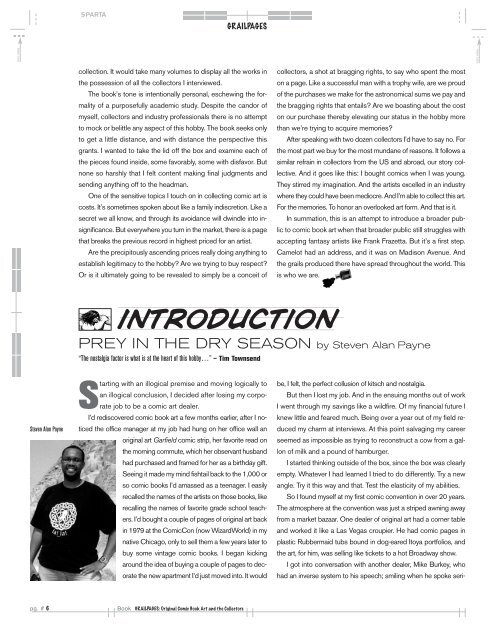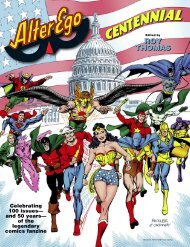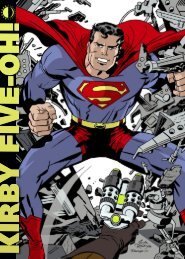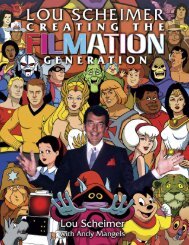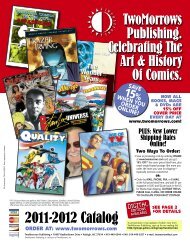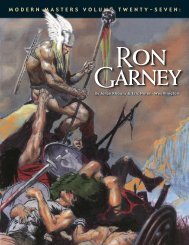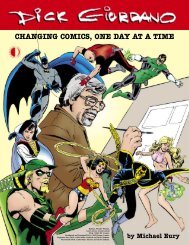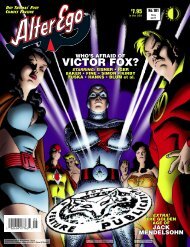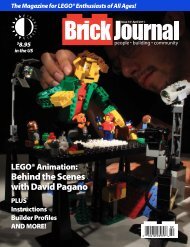Original Comic Book Art And The Collectors - TwoMorrows
Original Comic Book Art And The Collectors - TwoMorrows
Original Comic Book Art And The Collectors - TwoMorrows
Create successful ePaper yourself
Turn your PDF publications into a flip-book with our unique Google optimized e-Paper software.
COPY AREA<br />
Steven Alan Payne<br />
SPARTA<br />
pg. # 6 <strong>Book</strong> GRAILPAGES: <strong>Original</strong> <strong>Comic</strong> <strong>Book</strong> <strong>Art</strong> and the <strong>Collectors</strong><br />
GRAILPAGES<br />
collection. It would take many volumes to display all the works in<br />
the possession of all the collectors I interviewed.<br />
<strong>The</strong> book’s tone is intentionally personal, eschewing the formality<br />
of a purposefully academic study. Despite the candor of<br />
myself, collectors and industry professionals there is no attempt<br />
to mock or belittle any aspect of this hobby. <strong>The</strong> book seeks only<br />
to get a little distance, and with distance the perspective this<br />
grants. I wanted to take the lid off the box and examine each of<br />
the pieces found inside, some favorably, some with disfavor. But<br />
none so harshly that I felt content making final judgments and<br />
sending anything off to the headman.<br />
One of the sensitive topics I touch on in collecting comic art is<br />
costs. It’s sometimes spoken about like a family indiscretion. Like a<br />
secret we all know, and through its avoidance will dwindle into insignificance.<br />
But everywhere you turn in the market, there is a page<br />
that breaks the previous record in highest priced for an artist.<br />
Are the precipitously ascending prices really doing anything to<br />
establish legitimacy to the hobby? Are we trying to buy respect?<br />
Or is it ultimately going to be revealed to simply be a conceit of<br />
Starting with an illogical premise and moving logically to<br />
an illogical conclusion, I decided after losing my corporate<br />
job to be a comic art dealer.<br />
I’d rediscovered comic book art a few months earlier, after I noticed<br />
the office manager at my job had hung on her office wall an<br />
original art Garfield comic strip, her favorite read on<br />
the morning commute, which her observant husband<br />
had purchased and framed for her as a birthday gift.<br />
Seeing it made my mind fishtail back to the 1,000 or<br />
so comic books I’d amassed as a teenager. I easily<br />
recalled the names of the artists on those books, like<br />
recalling the names of favorite grade school teachers.<br />
I’d bought a couple of pages of original art back<br />
in 1979 at the <strong>Comic</strong>Con (now WizardWorld) in my<br />
native Chicago, only to sell them a few years later to<br />
buy some vintage comic books. I began kicking<br />
around the idea of buying a couple of pages to decorate<br />
the new apartment I’d just moved into. It would<br />
collectors, a shot at bragging rights, to say who spent the most<br />
on a page. Like a successful man with a trophy wife, are we proud<br />
of the purchases we make for the astronomical sums we pay and<br />
the bragging rights that entails? Are we boasting about the cost<br />
on our purchase thereby elevating our status in the hobby more<br />
than we’re trying to acquire memories?<br />
After speaking with two dozen collectors I’d have to say no. For<br />
the most part we buy for the most mundane of reasons. It follows a<br />
similar refrain in collectors from the US and abroad, our story collective.<br />
<strong>And</strong> it goes like this: I bought comics when I was young.<br />
<strong>The</strong>y stirred my imagination. <strong>And</strong> the artists excelled in an industry<br />
where they could have been mediocre. <strong>And</strong> I’m able to collect this art.<br />
For the memories. To honor an overlooked art form. <strong>And</strong> that is it.<br />
In summation, this is an attempt to introduce a broader public<br />
to comic book art when that broader public still struggles with<br />
accepting fantasy artists like Frank Frazetta. But it’s a first step.<br />
Camelot had an address, and it was on Madison Avenue. <strong>And</strong><br />
the grails produced there have spread throughout the world. This<br />
is who we are.<br />
INTRODUCTION<br />
PREY IN THE DRY SEASON by Steven Alan Payne<br />
“<strong>The</strong> nostalgia factor is what is at the heart of this hobby…” – Tim Townsend<br />
be, I felt, the perfect collusion of kitsch and nostalgia.<br />
But then I lost my job. <strong>And</strong> in the ensuing months out of work<br />
I went through my savings like a wildfire. Of my financial future I<br />
knew little and feared much. Being over a year out of my field reduced<br />
my charm at interviews. At this point salvaging my career<br />
seemed as impossible as trying to reconstruct a cow from a gallon<br />
of milk and a pound of hamburger.<br />
I started thinking outside of the box, since the box was clearly<br />
empty. Whatever I had learned I tried to do differently. Try a new<br />
angle. Try it this way and that. Test the elasticity of my abilities.<br />
So I found myself at my first comic convention in over 20 years.<br />
<strong>The</strong> atmosphere at the convention was just a striped awning away<br />
from a market bazaar. One dealer of original art had a corner table<br />
and worked it like a Las Vegas croupier. He had comic pages in<br />
plastic Rubbermaid tubs bound in dog-eared Itoya portfolios, and<br />
the art, for him, was selling like tickets to a hot Broadway show.<br />
I got into conversation with another dealer, Mike Burkey, who<br />
had an inverse system to his speech; smiling when he spoke seri-<br />
COPY AREA


